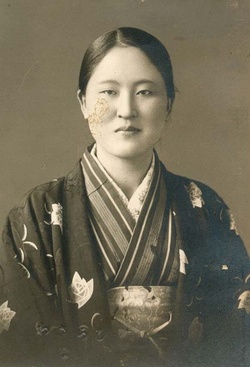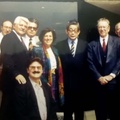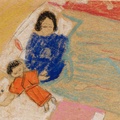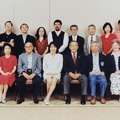Mitsuko Osaka was born in 1914 in the small town of Ina, Nagano Prefecture, the second of four daughters of the Osaka family. She grew up at the center of a well-off farming family. Her father, in addition to growing silkworms and rice, was the treasurer of a silk farmers’ cooperative. At the time, silk was one of Japan’s most important exports. Sericulture, or silk farming, was a way of life for hundreds of thousands of families in Nagano, as Mitsuko described in one of the first tankas she ever wrote.
the aroma of mulberry
permeates the cocoonery.
my mother, feeding new leaf,
was so youthful,
so beautiful.1
During her childhood, Mitsuko was witness to the series of freedoms that were expanded to the entire population during the Taisho period (1912–1926). The spirit and mentality of that era, known as Taisho democracy, would profoundly influence Mitsuko throughout her life. She attended the high school for girls in her town and thanks to the guidance of the school’s director, was educated in a progressive environment. Her school was one of the first to take students on a graduation trip throughout Japan, allowing the young women to visit cities like Yokohama and Kobe. These ports, with their cosmopolitan ambiance, had a significant impact on the students.
Seito (Bluestocking), a literary magazine published during those years, likewise reflected the spirit of that time. The magazine considered that women were like the moon, reflecting an external light. In its pages, therefore, the magazine’s editors sought to release that “hidden genius” within women. Years later, after she had immigrated to Mexico, Mitsuko did much more than reveal the genius she had previously kept to herself.
Mitsuko’s character and creativity were forged in the fire of difficult life experiences. In 1926, an employee stole from the silk cooperative and her father, the cooperative’s treasurer, was forced to pay the debt with family property. The other event that marked young Mitsuko’s life was the death of her mother the following year. These circumstances severely shattered the family’s well-being. Mitsuko was forced to leave school to devote herself to domestic duties and silk production.
A few years later, the economic situation of Nagano’s farmers, as well as farmers throughout Japan, received a devastating blow. The collapse of the New York stock market in 1929 had a drastic effect on producers of silk and cotton thread and textiles, who exported almost all of their goods to the United States. As textile factories throughout the world closed down, silk producers were left without a market for their product, and the income of rural Japanese families fell to just one-fifth of previous levels. Hunger and lack of work during those years haunted thousands of households in Nagano.
In light of this situation, Japanese workers and farmers were forced to emigrate in search of a better future outside Japan. One of those emigrants, by the name of Tsutomu Kasuga, left Nagano for Mexico in 1930. Tsutomu Kasuga hoped to work in the United States, where one of his sisters had emigrated years before. But the doors to that country were closed definitively to Japanese workers in 1924, when an anti-Japanese law with racist overtones was passed. So Tsutomu Kasuga decided to emigrate to Mexico, where a group of migrants from Nagano Prefecture had been established since the early years of the 20th century.
Upon arriving in Mexico, he worked on a small ranch close to the port of Tampico and the following year he settled in the town of Cerritos, in San Luis Potosí State, finding work in a bustling store belonging to Teikichi Iwadera.
By 1935, Tsutomu Kasuga was 25 years old and wanted to start a family. He sent a letter to relatives in Nagano asking them to find a young woman willing to move to Mexico and get married. The proposal was sent to Mitsuko, who accepted resolutely, despite knowing the pain she would experience as a result of moving far from her family, and not knowing whether she would ever see them again. Her luggage consisted of just one suitcase with a few items of clothing, a Japanese flag, and her book. She had written tanka and haiku from an early age, and would go on to master this activity in Mexico years later. She described her great determination to leave her land this way:
I defied everyone
when I crossed that ocean,
so it can’t be helped.
when I am in pain,
I accept my circumstances.
Also traveling on the boat with Mitsuko were the Endo sisters. Meeting for the first time on their voyage, they were also headed to the town of Cerritos with plans to marry two other Japanese migrants. In the port of Manzanillo, they were met by young Sadao Yamazaki, the future husband of one of the Endo sisters.
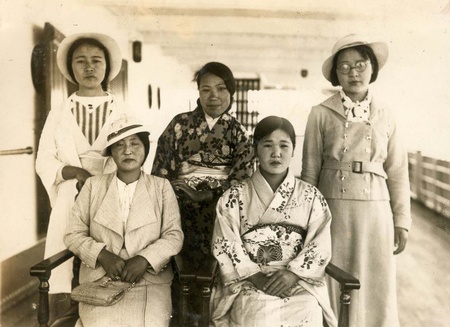
Once she arrived in Cerritos, and without any wedding party or ceremony, Mitsuko began working diligently alongside her husband in the store as well as in the fields. She gradually learned the Spanish language by serving the hundreds of customers who came to buy a wide variety of items such as sandals, hats, clothing, and work tools. To ease communication with customers, Mitsuko was given the Spanish name of Esperanza (hope).
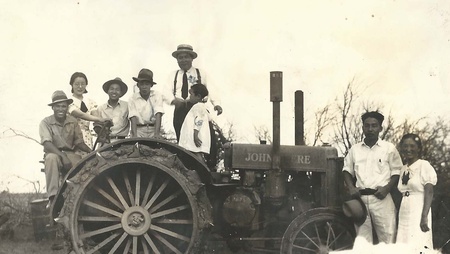
The year after her arrival, the first of her six children, Carlos Tsuyoshi Kasuga, was born in the store’s warehouse, with the help of a midwife.2 A few months after the birth of their son, the Kasuga family moved to the town of Cárdenas, in the same state, where they opened their own grocery store.
The store was successful, enabling the Kasugas to purchase a truck to deliver goods to nearby areas. Two years later, they bought land in the center of town to install a business, warehouse, and their own home. By 1941, the couple had two more children. In December of that year, news of the Japanese attack on Pearl Harbor was received with grave concern by the community of immigrants. When she heard the news, Mitsuko told her husband immediately, as she was afraid that they would have to close their business. The next day brought a great surprise. Their customers congratulated them, sympathizing with Japan rather than the United States. Anti-U.S. sentiment was high in Mexico, due to the history of insults by the U.S. government against Mexico. Just three years later, the government of President Lázaro Cárdenas had expropriated U.S. and British oil companies, a measure that garnered him widespread support among the Mexican people.
The U.S. government, as part of its continent-wide policy against Japanese immigrants, asked the Mexican government to concentrate Japanese residents and their descendants in the center of the country, far from the U.S. border. The Kasuga family received the order to move to Mexico City in mid-1942. Local authorities and other residents of their community and other communities sent letters to the federal government asking that the immigrants be allowed to remain in the towns where they lived, since not only were they honest and hard-working people, they were considered part of their communities. On the night that the Kasuga family left on a train for Mexico City, the people gathered at the train station included not only friends but the same local officials. This profoundly moved Mitsuko, who through her tears thanked them for this gesture of friendship and trust. Perhaps because of this support from the Mexican people, Mitsuko no longer considered herself an immigrant or foreigner, but instead felt that she belonged in Mexico.
For the Kasuga family, the move to Mexico City was yet another emigration to Mexico. Fortunately, the “concentration” enabled families arriving from different parts of Mexico to organize and support one another. The immigrants tended to settle in certain neighborhoods in Mexico City, enabling them to create schools where their children could study the Japanese language and other subjects in the afternoon.
Throughout the war, Tsutomu Kasuga earned a living by selling vegetables, enabling the family to survive those difficult years. In writing tankas, Mitsuko expressed, despite the adversity, her great optimism about a life in Mexico:
ten years ago
I married this man.
we are poor,
yet my five children
fill my heart.
When the war ended in 1945, the government allowed Japanese immigrants to return to the towns where they had previously lived. But the vast majority decided to stay in Mexico City, where they saw greater opportunities for their children to study beyond secondary school. Tsutomu and Mitsuko sold their house in Cárdenas and with that money, opened a candy shop in partnership with the Yamazaki family. The store was so successful that he was able to buy two more stores several years later. Mitsuko was in charge of making a kind of Mexican-style umeboshi (chamoy) from dried and salted apricots, which became very popular with Mexican consumers.
In addition to helping her husband with work, Mitsuko also focused on the education of her children and the children of the entire Japanese community in her neighborhood of Tacubaya. She set up one of the many new schools in her own home, personally making sure that the children would not miss classes because of the lack of a teacher or an appropriate place.
In the late 1950s, the Kasuga decided to start a new business—producing inflatable plastic toys. They set up a small factory with other immigrants and named the company Kay. Their toy production venture was highly successful—sales grew and the company began to export to countries in Central and South America.
In 1968, Mitsuko was filled with pride when the factory to which her family had dedicated so much effort was chosen to make the Olympic rings that would be raised up high during the opening ceremony of the Olympic Games in Mexico City. Mitsuko was also proud that her country had been chosen as the site of the Olympic Games, since by then she felt completely Mexican.
quesadillas of
squash blossom and
Huitlacoche3
are my special favorite.
I am becoming Mexican.
The years to come would bring great happiness but also difficult personal loss for Mitsuko. The Kasuga family expanded with the addition of grandchildren, who represented one of her greatest pleasures; but her father, still living in Japan, died in 1972. This loss was not only very painful for Mitsuko, but also brought out feelings of nostalgia that distanced her yet further from her native land.
I stare
at the single point where
the sun sets in the sea.
father and mother are gone,
my hometown ever distant.
Just one year later, Tsutomu died unexpectedly. Suddenly, like a lightning bolt, death had taken him away, leaving an enormous task to be done: the creation of a single school for the entire Japanese community that would bring Japan and Mexico closer together by providing a bi-cultural education, open to the Mexicans who had welcomed them. Mitsuko, along with her children and many other immigrants, created the Mexican-Japanese High School in 1977, and it eventually became one of the most prestigious schools in Mexico City.
In 1987, Mitsuko was decorated by the Emperor in recognition of her contribution to the Nikkei community. By then, her tankas were not only widely known in Mexico, but in Japan the Asahi newspaper and later the Imperial Family recognized Mitsuko’s talent by publishing her poems under the name Akane. In 2002, Akane, like the reddish beams of light at dusk, gradually faded away, leaving a profound imprint on the country that opened its arms to receive her and where her ashes now rest.
directly facing
the peak of Mount Popo4,
cosmos
cover this hill.
I’ve chosen my burial place.
Notes:
1. Mitsuko’s tankas were compiled and edited by Aiko Chikaba in the book Akane: The Tanka of Mitsuko Kasuga, a Japanese Migrant in Mexico. Artes Gráficas Panorama, 2015. Available on Amazon.com.
2. Carlos Kasuga is one of the most widely recognized leaders of the Nikkei community in Mexico. He previously served as the president of the Pan-American Nikkei Association.
3. Quesadillas are folded tortillas filled with various vegetables, flowers, or stewed meat with cheese. Huitlacoche is an edible fungus that grows on the ears of corn. The flower referred to in the tanka is the squash flowers.
4. “El Popo” is the Mexican nickname for the Popocatepetl volcano.
© 2016 Sergio Hernández Galindo


